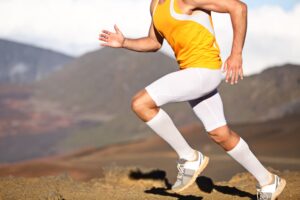
There is a logical reason to think that graduated compression (tighter near the ankle and slightly looser further up) would be helpful during exercise for a couple of reasons. First, is added support of the veins under the garment. As blood flow increases during exercise, the veins can become stretched out and allow that blood to pool in the legs. That makes the legs heavier and can cause them to tire more easily. Providing extra support from the surface with a compression garment can prevent overfilling of the veins, and keep the blood flowing back to the heart. Better return of blood to the heart means it can be re-oxygenated and circulated back out to the muscles that need it.
Similarly, compression helps improve the efficiency of the calf muscle pump. Remember, this is the mechanism that pushes blood uphill through the veins in the legs. A compression garment gives the muscles something more to push against, increasing the force of the squeeze on the veins, propelling more blood up the leg with each contraction.
So it sounds logical that compression garments can help increase venous efficiency and blood return to the heart during exercise, but is there any evidence to show that they actually do? There have been a number of scientific studies of this question over the past few years. Here are a few highlights of the findings:
- During exercise, compression stockings enhanced endurance and preserved strength. Runners were found to be able to run farther without fatiguing. After running, test subjects who had been wearing compression were able to jump higher than those who had not.[1],[2]
- After exercise, compression stockings seem to shorten the time needed for muscle recovery. [3] This is probably due to improved venous return, and faster clearance of lactate and other waste products from the exercising muscles, all of which have been demonstrated in various studies.
- The theory that improving venous return to the heart with compression should improve the efficiency of the heart and lungs has not shown to be true. A recent study out of Sweden showed no difference in the heart rate, cardiac output (measure of how much effectively the heart is pumping), arterial-venous oxygen difference (a measure of how efficiently blood is being re-oxygenated in the lungs), or any other metabolic measures between runners wearing compression garments or not.[4]
To summarize, there is evidence of benefit to the muscles being supported by the compression garment, but no evidence of benefit to the overall efficiency of the heart and lungs. A lightweight compression seems to be adequate to provide benefit in the legs, and is reported to be comfortable by most athletes surveyed. Contact our office if you would like more information about compression sleeves or recovery socks available from Sigvaris.
[1] Bringare A, et al. Aerobic energy cost and sensation responses during submaximal running exercise – positive effects of wearing compression tights. Int. Journal of Sports Medicine 2006;27:373-378.
[2] Rugg S, et al. The effect of graduated compression tights, compared with running shorts, on counter movement jump performance before and after submaximal running. J Strength Cond Research. 2013 Apr;27(4):1067-73.
[3] Gill ND, et al. Effectiveness of post-match recovery strategies in rugby players. British Journal of Sports Medicine 2006;40:260-63
[4] Sperlich B, et al. Cardio-respiratory and metabolic responses to different levels of compression during submaximal exercise. Phlebology 2011;(26):102-106.